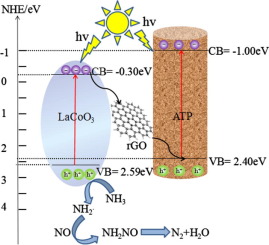Journal of Catalysis ( IF 7.3 ) Pub Date : 2017-11-20 , DOI: 10.1016/j.jcat.2017.10.024 Xiazhang Li , Xiangyu Yan , Xiaowang Lu , Shixiang Zuo , Zhongyu Li , Chao Yao , Chaoying Ni

|
Photo-assisted selective catalytic reduction (photo-SCR) has been recognized as a promising strategy for NOx removal in recent decade, however rational designing of efficient and low-cost catalyst for photo-SCR remains to be a challenge. In the present work, natural one-dimension attapulgite (ATP) clay was initially coated with perovskite oxides by sol–gel method, and then coupled with reduced graphene oxide (rGO) by electrostatic assembly. XRD, TEM, Raman, UV–Vis, XPS, NH3-TPD, H2-TPR and in situ EPR were employed to characterize the products. Results indicated that the framework was coherently integrated by ATP skeleton, LaCoO3 particles and rGO nanosheet, while rGO behaved as excellent electronic transmission mediator between ATP and LaCoO3 to achieve indirect Z-scheme system, thus significantly improved the charge-separation efficiency and redox ability of the nanocomposite. In situ EPR revealed that the photogenerated holes in the catalysts were captured by NH3 to produce NH2 radical, which produced NH2NO intermediate followed by decomposing into N2 and H2O. Photo-SCR of NO was performed using LaCoO3/ATP/rGO as catalyst under simulated solar-light irradiation. Results indicated that the introduction amount of rGO had critical effect on the NO conversion efficiency, which reached as high as 95% conversion rate and 100% N2 selectivity even under room temperature when the mass content of rGO was optimized to 0.6 wt%. In addition, SO2 and H2O tolerance experiment did not find noticeable deactivation of the obtained Z-scheme photocatalyst, which was attributed to the synergistic resistance effect between ATP and rGO.
中文翻译:

Z方案基于天然粘土的光催化剂光辅助选择性催化还原NO的研究:深入了解石墨烯偶联的作用
光辅助的选择性催化还原(照片-SCR)已被确认为一个有前途的战略NO X在最近十年中去除,用于光SCR高效和低成本的催化剂但是理性的设计仍然是一个挑战。在目前的工作中,天然一维凹凸棒石(ATP)粘土首先通过溶胶-凝胶法涂覆钙钛矿氧化物,然后通过静电组装与还原型氧化石墨烯(rGO)偶联。用XRD,TEM,拉曼,UV-Vis,XPS,NH 3 -TPD,H 2 -TPR和原位EPR表征产物。结果表明该框架是由ATP骨架LaCoO 3紧密集成的。颗粒和rGO纳米片,而rGO充当ATP和LaCoO 3之间的优良电子传输介质,以实现间接Z方案系统,从而显着提高了纳米复合材料的电荷分离效率和氧化还原能力。原位EPR透露,在催化剂中的光生空穴由NH捕获3以产生NH 2基团,NH其产生2 NO中间体接着分解成Ñ 2和H 2 NO的O.照片-SCR使用LaCoO进行3/ ATP / rGO在模拟太阳光照射下作为催化剂。结果表明,rGO的引入量对NO的转化效率有关键影响,当将rGO的质量含量优化为0.6 wt%时,即使在室温下,rGO的转化率也高达95%,N 2选择性高达100 %。另外,对SO 2和H 2 O的耐受性实验未发现所获得的Z型光催化剂有明显的失活,这归因于ATP和rGO之间的协同抗性效应。


























 京公网安备 11010802027423号
京公网安备 11010802027423号